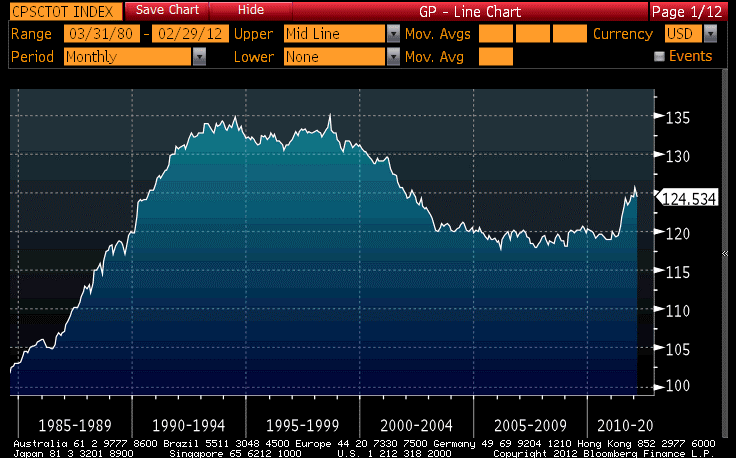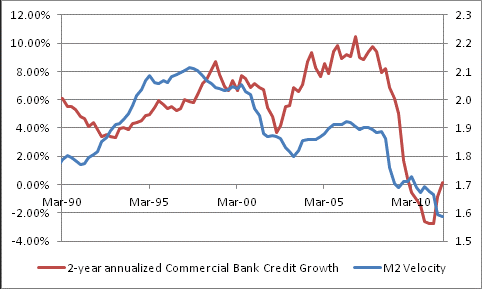If 15 months of rising core inflation did not a trend make, then surely one month of declining core inflation also does not. Nevertheless, with confirmation bias doubtless in play, the decline in ex-food-and-energy CPI to 2.177% from 2.277% probably brings QE3 back into play.
Confirmation bias, for readers unfamiliar with the term, is the behavioral tendency for people to emphasize information that confirms what they already believe and to dismiss contrary information. So, for example, an economist who is forecasting that inflation will slow (and who has been forecasting that for months now, perhaps also not having forecast the fastest rise in almost 20 years of 1.7% over the prior 15 months) will see in today’s number a confirmation of his/her beliefs, but never questions why there were so many prior misses. In this way, a bad economist is like a good cornerback – they both have short memories!
So here is the market implication of today’s slip: the hawks on the FOMC had been gaining ground in persuading the doves to hold off on QE3, partly due to economic recovery but also due to the fact that inflation looked to be accelerating uncomfortably. Chairman Bernanke seems to have an itchy trigger finger on QE3, but the argument for it weakens considerably even if there is somewhat weak growth unless inflation also slows. Since FOMC members are as subject to confirmation bias as are any other humans, I think this single number puts QE3 back into play (especially with bonds weakening lately).
Not wanting to be accused of confirmation bias myself, let’s look at today’s inflation release critically. Most of the major groups decelerated: Food & Beverages, Housing, Apparel, Medical Care, Recreation, and Other. Those groups account for about 78% of the CPI; accelerating were Transportation (mostly due to fuel) and Education/Communication.
To have three quarters of the basket decelerating is a big change from the recent tilt the other way, but it isn’t quite as obvious as that. First of all, within the Housing major group Owners’ Equivalent Rent was flat, “Rent of primary residence” rose, and “Lodging away from home” rose. The primary cause of the decline in the Housing major group was the sharp fall in “Fuels and utilities,” driven by large declines in Fuel Oil, Propane, kerosene, and firewood, Electricity, and Utility (piped) gas service. In other words, the 5.27% of the CPI that was “Fuels and utilities” under “Housing” ought to go in the declines column while the other 34.95% that is Housing ought to be in “accelerating.” That moves the tally to 41.85% decelerating, with 58.15% accelerating, which is much closer to the prior diffusion. So this decline isn’t as dramatic as it looks at first blush.
Another component where there was a sharp fall was Apparel. Last month saw an 0.9% rise in Apparel prices; this month we got an 0.9% decline. Confirmation bias kicks in, and virtually every economist pointed to “payback from a surprising increase in Apparel.” I don’t see Apparel’s increase as so automatically surprising (see my comment on Apparel last month here). It seems to me, even with this correction, that Apparel is looking a lot more like it did pre-1993 than since then (see Chart).
The +0.9% followed by -0.9% is more likely to be a seasonal glitch than a reversal in trend – the non-seasonally-adjusted data show a sharp fall in January and a sharp rise in February. In other words, the seasonal adjustment factors expected a sharper decline in January apparel prices, which usually accompanies post-holiday clearance sales, than actually happened in January. This is probably a weather effect, and I’d expect Apparel to resume its rise next month.
Aside from the minutia, let’s look at the bigger picture and let me extend my comments from yesterday about the expansion of commercial bank credit. A reader asked me why commercial bank credit matters, and whether the recent decline in monetary velocity to levels never seen before is a more-dependable precursor to deflationary doom, as no lesser pundit than Ambrose Evans-Pritchard seems to believe.
Should we worry about the decline in the velocity of money? Of course we should, and that is why the Fed did QE1 and one reason they are considering QE3. But remember that we don’t measure money velocity directly. Money velocity is a residual value from the equation MV≡PQ, where we calculate M, P, and Q and therefore derive V. Since we don’t measure velocity directly, we have to rely on signs that velocity is changing. The collapse in bank lending during the crisis was a terrific signal that money supply growth would not be immediately inflationary, because velocity was clearly plunging (velocity is, coarsely, how many times a dollar gets spent in a year, and with the banks sitting on every dollar that came their way, they couldn’t get spent as many times!).
The return of lending to something like its normal range is disturbing, in one sense, because a return of velocity to its normal range would be worrisome with the money supply itself still growing robustly. But is there really such a link? I asserted it, but I didn’t show it. So let me show it.
The chart below shows the 2-year annualized growth of Commercial Bank Credit, in red and measured on the left axis, versus M2 velocity, in blue and measured on the right axis. Since 1990, the quarterly correlation is an impressive 0.51, and I am sure with some further massaging I could improve the correlation further.
The last point on the chart is from December. If the quarter ended today, the 2-year compounded rise in Commercial Bank Credit would be 1.9%.
Let me illustrate how much a rebound in velocity would matter. Over the last four years ended in December, M2 rose about 28.5% and velocity has declined 16.2% (so M*V rose 7.7%). GDP has risen 0.8% (that’s a total of 0.8%!) in constant dollars and the core PCE deflator rose 6.5% (so P*Q rose 7.4%).[1]
Now suppose that over the next two years, velocity rebounds to 1.9 (a rise of about 20% from the current level) and money supply growth slows to only 8% per year. That puts M*V +40% in two years. Let’s assume that real GDP soars, because of wise leadership and surging consumer confidence — stifle the laughter, this is a thought experiment — at +5% per annum. That means prices would rise by roughly, um, 27% in two years [1.4/(1.05^2)].
So yes, velocity matters. And yes, the recovery in commercial bank credit probably tells us something about what is going to be happening to velocity now, and in the near future.
So no, the 0.1% decline in year-on-year core CPI doesn’t change my view.
I promised myself I wouldn’t make any snide comments about the wisdom of the Fed going all social-media on us by opening a Twitter account. However, it depresses me that I have been tweeting for a couple of years at @inflation_guy and have only 352 followers, but @federalreserve already has 15,658. So come on, help me catch up! We can do it! Note that this comment is released on Twitter, and also note that if you are on Bloomberg and can’t get Twitter behind your compliance wall, you can still get my tweets (such as they are) by typing NH TWT and then searching for Michael Ashton.
- English (UK)
- English (India)
- English (Canada)
- English (Australia)
- English (South Africa)
- English (Philippines)
- English (Nigeria)
- Deutsch
- Español (España)
- Español (México)
- Français
- Italiano
- Nederlands
- Português (Portugal)
- Polski
- Português (Brasil)
- Русский
- Türkçe
- العربية
- Ελληνικά
- Svenska
- Suomi
- עברית
- 日本語
- 한국어
- 简体中文
- 繁體中文
- Bahasa Indonesia
- Bahasa Melayu
- ไทย
- Tiếng Việt
- हिंदी
Has Inflation Really Turned, As The Fed Expected?
Published 03/18/2012, 03:06 AM
Updated 02/22/2024, 09:00 AM
Has Inflation Really Turned, As The Fed Expected?
3rd party Ad. Not an offer or recommendation by Investing.com. See disclosure here or
remove ads
.
Latest comments
Install Our App
Risk Disclosure: Trading in financial instruments and/or cryptocurrencies involves high risks including the risk of losing some, or all, of your investment amount, and may not be suitable for all investors. Prices of cryptocurrencies are extremely volatile and may be affected by external factors such as financial, regulatory or political events. Trading on margin increases the financial risks.
Before deciding to trade in financial instrument or cryptocurrencies you should be fully informed of the risks and costs associated with trading the financial markets, carefully consider your investment objectives, level of experience, and risk appetite, and seek professional advice where needed.
Fusion Media would like to remind you that the data contained in this website is not necessarily real-time nor accurate. The data and prices on the website are not necessarily provided by any market or exchange, but may be provided by market makers, and so prices may not be accurate and may differ from the actual price at any given market, meaning prices are indicative and not appropriate for trading purposes. Fusion Media and any provider of the data contained in this website will not accept liability for any loss or damage as a result of your trading, or your reliance on the information contained within this website.
It is prohibited to use, store, reproduce, display, modify, transmit or distribute the data contained in this website without the explicit prior written permission of Fusion Media and/or the data provider. All intellectual property rights are reserved by the providers and/or the exchange providing the data contained in this website.
Fusion Media may be compensated by the advertisers that appear on the website, based on your interaction with the advertisements or advertisers.
Before deciding to trade in financial instrument or cryptocurrencies you should be fully informed of the risks and costs associated with trading the financial markets, carefully consider your investment objectives, level of experience, and risk appetite, and seek professional advice where needed.
Fusion Media would like to remind you that the data contained in this website is not necessarily real-time nor accurate. The data and prices on the website are not necessarily provided by any market or exchange, but may be provided by market makers, and so prices may not be accurate and may differ from the actual price at any given market, meaning prices are indicative and not appropriate for trading purposes. Fusion Media and any provider of the data contained in this website will not accept liability for any loss or damage as a result of your trading, or your reliance on the information contained within this website.
It is prohibited to use, store, reproduce, display, modify, transmit or distribute the data contained in this website without the explicit prior written permission of Fusion Media and/or the data provider. All intellectual property rights are reserved by the providers and/or the exchange providing the data contained in this website.
Fusion Media may be compensated by the advertisers that appear on the website, based on your interaction with the advertisements or advertisers.
© 2007-2024 - Fusion Media Limited. All Rights Reserved.
